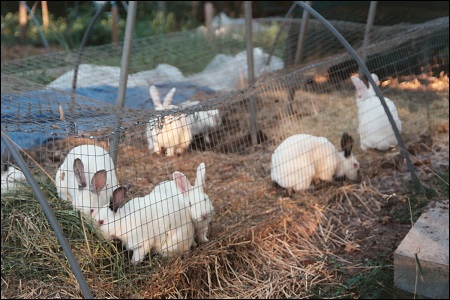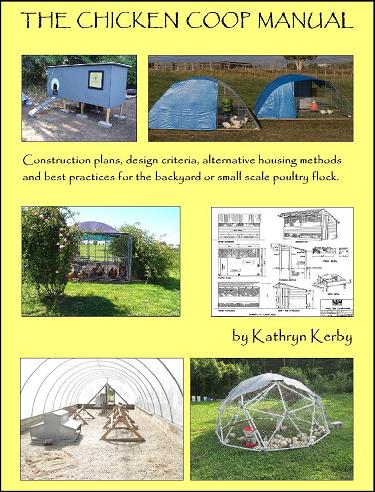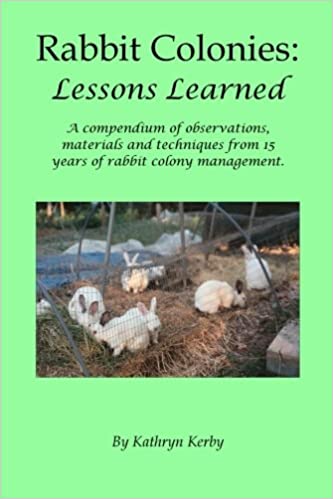|
Search this site for keywords or topics..... | ||

Custom Search
| ||
Rabbit Colonies

Rabbit Colonies: Lessons Learned
ANNOUNCEMENT: It's finally here! Our latest publication, Rabbit Colonies: Lessons Learned has just been released!
Are you interested in switching over to colony housing for your rabbits? Are you already using this method and experiencing some complications, or want to make your approach more effective? If so, you may be interested in a project we've been working on here. Rabbit Colonies: Lessons Learned is an in-depth compilation of everything we've learned in the last 15 years of working with rabbit colonies. We have put this work together as a large PDF document. It is chock-full of the issues we've faced over the last 15 years, and detailed descriptions for how we solved them.
Here's a small sampling of what our publication covers:
- Different pen designs and the pro's and con's of each
- Dietary issues when feeding rabbits on pasture, and how to adjust their diet accordingly
- Predator problems and solutions
- Disease transmission and risks within rabbit populations, and how to address them
- Differences between adult and kit housing needs, and how to deal with them
- Breeding and kindling options, and how to avoid problems
- Weather extremes and options for weatherproofing your rabbits
- How to set up colony operations for chores efficiency
Imagine the benefits of having all this information up front, instead of facing these challenges one after another and having to reinvent the wheel! We have created this publication as if we were talking about these issues with you over the kitchen table, working through whatever ideas, challenges or goals you're working on. We know this information will provide many benefits to those who want to switch over to colony rabbit management, and those who want to make their existing operation better.
FOR MORE INFORMATION, click on our Rabbit Colonies: Lessons Learned production information page.
*You can shop with confidence with Frog Chorus Farm; we offer a money-back guarantee on all our products.*
Rabbit Colonies: Modern Options for Natural Production
Today's domesticated rabbits are generally housed in single occupancy
wire cages. Each cage is often no bigger than 2' x 3' in size, and is
often suspended off the ground so that the animal's manure and urine can
drain freely through the cage mesh to a collection point below. The
vast majority of rabbits never spend any time outside those cages
getting exercise, grazing, socializing or building nests. From the
rabbit's perspective, that's a pretty dull life.
In contrast, domesticated rabbits which are kept as pets have proven to
do well under very different conditions. They can be trained to a
litter box, they enjoy socializing with other rabbits (and even other
animals), they enjoy hiding under natural overhangs and in cubby-holes,
and they very much enjoy grazing grassy and brushy growth. If I were a
rabbit, I'd definitely prefer housing which wasn't limited to the
contents of a wire cage, and which allowed some opportunities for more
natural behaviors such as social grooming, grazing and hiding under
cover.
For folks who want to provide species-appropriate housing for their
rabbits, there is a compromise between these two options. That
middle-ground is informally known as colony housing. That's the system
we use here, and we've generally been pretty happy with it. It is a bit
more work than single occupancy wire cages, and it doesn't offer quite
as many niceties as total freedom would offer to pet rabbits. Yet we
feel it is a good compromise.
Rabbit Colony Housing Details
Colony housing is nothing very complicated, and different farms will use slightly different setups:
* housing can be anything that provides adequate space and protection
for the rabbits within. That could be a large traditional hutch
suspended off the ground, a ground-level fenced enclosure, or some
combination. The housing would have to provide cover from both direct
sun and precipitation.
* groups can vary depending on how and why they are being raised. One
common grouping is same-sex, same age batches, destined for sale or for
harvest. Another common grouping is a mixed-sex batch of littermates,
also being kept together until sale, harvest, or separating into
breeding groups. Other common groupings are dry does, bachelor bucks,
and mating groups of one buck with 2-6 does.
* most colonies have fencing tall enough that the rabbits can't climb or
jump over. Some colonies are allowed to dig, but that presents the
risk of the rabbits digging out of their enclosure. Some colonies are
maintained on solid flooring so they can't dig, for instance in barn
stalls with wooden plank or poured concrete footing. In that case, the
rabbits must be on either absorbent bedding or litter trained. Since
rabbits so intensely enjoy digging, one compromise is to offer a kids'
wading pool filled with dirt, so the rabbits can do limited digging
without actually getting out of the enclosure.
* Pregnant does can be housed in colony settings, with some adjustments.
Some herds are maintained with satellite nesting tunnels, rooms or
chambers which each doe can choose as she will. Some of those nesting
arrangements also allow the human manager to work with the kits either
by closing the doe out of the nest chamber, or simply lifting the nest
box out of the enclosure. Some herds are maintained with the does kept
in the group housing up until they are near delivery, at which time they
are segregated away from the herd into more conventional individual
cages.
* Feeding and watering can be handled just as with conventional
single-occupation cages, or with a variety of alternatives. We have
used wide through-the-wall pellet feeders with good results. We have
also used hay feeders with good results. We have occasionally fed bulk
roots and/or greens right in the main group cage, in different piles or
bunches so that all the rabbits get a chance to eat. Only rarely have
we seen dominance displays such that low-ranking rabbits were deprived
of food.
* Medical care, either proactive or in case of injury/illness, is one of
the few drawbacks to colony housing. Our first colony arrangement was a
large pen which gave the rabbits plenty of room to exercise. But the
rabbits would scatter when it came time to check individuals for
pregnancy, segregate animals for any reason or treat minor illness or
injury. We eventually rigged up a way to divide the group pen into
smaller and smaller pens, thereby restricting the rabbits' movements
until we could more easily capture the one(s) we wanted. As we build
newer pens, we build in gates and other division methods so that we can
quickly restrict the rabbits into small spaces where they can most
easily be handled.
Getting Started
Any rabbits can conceivably transferred from individual housing to group housing, but there are ways to make the transition easier. The easiest way is to start with siblings who have already been together since birth. They can very easily be managed either in same-sex or mixed-sex groups for at least the first three months. Beyond that point, they must be segregated by sex to prevent unwanted breeding. Groups of does can generally be brought together, but it helps to give them a larger-than-usual group pen while they sort out their pecking order. It also helps to provide a multitude of hiding spots and furniture so that they can get away from each other for the same reason. Sometimes a single doe will be so dominant that she beats up on everyone; she may need to be kept permanently segregated from the whole. Similarly, sometimes a doe will be so low on the totem pole that everyone beats up on her. Again, she may need to be kept apart, or paired with younger animals which aren't so aggressive. Buck groups often work the same way - most of them get along as long as does are not around, but the occasional dominant or submissive animal might need to be separated.
Our Rabbit Colony Layouts
Our colony housing serves three purposes:
1) Maintain our rabbits in either breeding groups, or sale groups
2) Graze grassy or brushy areas
3) either build or fertilize new/existing garden planting beds
Our first colonies were big wire pens out on grass. We moved the pens
frequently and systematically over the pasture, so that the rabbits were
always on fresh ground. That approach worked very well for using that
particular piece of ground, and it cut down on our feed bill. But one
spring, we got really busy and ended up leaving one of the pens in the
same place for a number of months. Since the rabbits were on the
ground, rather than suspended, we had to keep putting down bedding so
that they would not be standing in their own waste. It was labor
intensive but we just worked with it until we had the chance to move
them. After moving that pen, we discovered that the rabbits' long term
stay on that piece of ground had created a wonderful planting bed of
almost the same size - 4' by 20' - that we were already using at the
time. Given that experience, we now use some of the rabbit pens to
deliberately create and fertilize future planting areas.
We have changed our pen design. Instead of one big square or round open
area, we use the same 4'x 20' size. We build walls and doors into the
enlosure such that we can open or close off different sections. This
makes segregating and handling the animals much easier. Right now we
breed in the group pen but we don't kindle there; instead we pull the
does out and put them in separate cages. As the kits grow, we put them
in their own group pen for grow-out.
We really like this system for its improved quality of life for the
animals. Contrary to our previous suspicions, it actually makes
management a bit easier because we're only servicing a few group pens
instead of dozens or hundreds of individual pens. We do use a bit more
cage wire to build all the different group pens, but assembly goes much
faster than assembling new single-occupancy cages. Best of all, we
don't have the rust-through in the floors like often happens with
single-occupancy cages. This is because the rabbits move around so much
more and don't pee or poop in just one place.
We hope you consider colony housing for your rabbits. We have been very
happy with it, and I think the rabbits have been happy with it too.
Rabbit Books
Sponsored Products
Our Successful Farming and Ranching Books

We released our very first self-published book. The Chicken Coop Manual in 2014. It is a full color guide to conventional and alternative poultry housing options, including 8 conventional stud construction plans, 12 alternative housing methods, and almost 20 different design features. This book is available on Amazon.com and as a PDF download. Please visit The Chicken Coop Manual page for more information.

Rabbit Colonies: Lessons Learned
We started with rabbits in 2002, and we've been experimenting with colony management ever since. Fast forward to 2017, when I decided to write another book, this time about colony management. The book is chock-full of practical information, and is available from both Amazon and as a PDF download. Please visit the Rabbit Colonies page for more information.
The Pastured Pig Handbook
We are currently working on our next self-published book: The Pastured Pig Handbook. This particular book addresses a profitable, popular and successful hog management approach which sadly is not yet well documented. Our handbook, will cover all the various issues involved with pastured hog management, including case studies of numerous current pastured pig operations. If you have any questions about this book, please Contact Us.